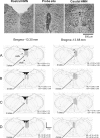Modulation of genioglossus muscle activity across sleep-wake states by histamine at the hypoglossal motor pool
- PMID: 19848360
- PMCID: PMC2753809
- DOI: 10.1093/sleep/32.10.1313
Modulation of genioglossus muscle activity across sleep-wake states by histamine at the hypoglossal motor pool
Abstract
Study objectives: Histamine neurons comprise a major component of the aminergic arousal system and significantly influence sleep-wake states, with antihistamines widely used as sedative hypnotics. Unlike the serotonergic and noradrenergic components of this arousal system, however, the role of histamine in the central control of respiratory motor activity has not been determined. The aims of this study were to characterize the effects of histamine receptor agonists and antagonists at the hypoglossal motor pool on genioglossus muscle activity across sleep and awake states, and also determine if histamine contributes an endogenous excitatory drive to modulate hypoglossal motor outflow to genioglossus muscle.
Design, participants, and interventions: Thirty-three rats were implanted with electroencephalogram and neck electrodes to record sleep-wake states, and genioglossus and diaphragm electrodes for respiratory muscle recordings. Microdialysis probes were inserted into the hypoglossal motor nucleus.
Measurements and results: Histamine at the hypoglossal motor nucleus significantly increased tonic genioglossus muscle activity in wakefulness, non-REM sleep and REM sleep. The activating effects of histamine on genioglossus muscle activity also occurred with a histamine type-1 (H1) but not H2 receptor agonist. However, H1 receptor antagonism at the hypoglossal motor nucleus did not decrease genioglossus muscle activity in wakefulness or sleep.
Conclusions: The results suggest that histamine at the hypoglossal motor pool increases genioglossus muscle activity in freely behaving rats in wakefulness, non-REM, and REM sleep via an H1 receptor mechanism.
Figures






Similar articles
-
GABAA receptor antagonism at the hypoglossal motor nucleus increases genioglossus muscle activity in NREM but not REM sleep.J Physiol. 2003 Apr 15;548(Pt 2):569-83. doi: 10.1113/jphysiol.2002.033696. Epub 2003 Feb 28. J Physiol. 2003. PMID: 12611924 Free PMC article.
-
Application of histamine or serotonin to the hypoglossal nucleus increases genioglossus muscle activity across the wake-sleep cycle.J Sleep Res. 2009 Mar;18(1):113-21. doi: 10.1111/j.1365-2869.2008.00708.x. J Sleep Res. 2009. PMID: 19250178
-
Endogenous excitatory drive modulating respiratory muscle activity across sleep-wake states.Am J Respir Crit Care Med. 2006 Dec 1;174(11):1264-73. doi: 10.1164/rccm.200605-597OC. Epub 2006 Aug 24. Am J Respir Crit Care Med. 2006. PMID: 16931636
-
K+ channel modulation causes genioglossus inhibition in REM sleep and is a strategy for reactivation.Respir Physiol Neurobiol. 2013 Sep 15;188(3):277-88. doi: 10.1016/j.resp.2013.07.011. Epub 2013 Jul 18. Respir Physiol Neurobiol. 2013. PMID: 23872455 Review.
-
Emerging principles and neural substrates underlying tonic sleep-state-dependent influences on respiratory motor activity.Philos Trans R Soc Lond B Biol Sci. 2009 Sep 12;364(1529):2553-64. doi: 10.1098/rstb.2009.0065. Philos Trans R Soc Lond B Biol Sci. 2009. PMID: 19651656 Free PMC article. Review.
Cited by
-
Histamine/H1 receptor signaling in the parafacial region increases activity of chemosensitive neurons and respiratory activity in rats.J Neurophysiol. 2022 Jul 1;128(1):218-228. doi: 10.1152/jn.00015.2022. Epub 2022 Jun 15. J Neurophysiol. 2022. PMID: 35704395 Free PMC article.
-
Standard Correction of Vision Worsens EMG Activity of Pericranial Muscles in Chronic TMD Subjects.Pain Res Manag. 2020 Apr 13;2020:3932476. doi: 10.1155/2020/3932476. eCollection 2020. Pain Res Manag. 2020. PMID: 32351638 Free PMC article.
-
The effect of tongue exercise on serotonergic input to the hypoglossal nucleus in young and old rats.J Speech Lang Hear Res. 2012 Jun;55(3):919-29. doi: 10.1044/1092-4388(2011/11-0091). Epub 2012 Jan 9. J Speech Lang Hear Res. 2012. PMID: 22232395 Free PMC article.
-
Impact of histaminergic H3 receptor antagonist on hypoglossal nucleus in chronic intermittent hypoxia conditions.Psychopharmacology (Berl). 2021 Jan;238(1):121-131. doi: 10.1007/s00213-020-05663-0. Epub 2020 Sep 22. Psychopharmacology (Berl). 2021. PMID: 32964244
-
The Combination of Betahistine and Oxybutynin Increases Respiratory Control Sensitivity (Loop Gain) in People with Obstructive Sleep Apnea: A Randomized, Placebo-Controlled Trial.Nat Sci Sleep. 2022 Jun 7;14:1063-1074. doi: 10.2147/NSS.S362205. eCollection 2022. Nat Sci Sleep. 2022. PMID: 35698591 Free PMC article.
References
-
- Jones BE. Basic mechanisms of sleep-wake states. In: Kryger MH, Roth T, Dement WC, editors. Principles and practice of sleep medicine. 2nd ed. Philadelphia: Saunders; 1994. pp. 145–62.
-
- Jacobs BL, Azmitia EC. Structure and function of the brain serotonin system. Physiol Rev. 1992;72:165–229. - PubMed
-
- Foote SL, Bloom FE, Aston-Jones G. Nucleus locus ceruleus: new evidence of anatomical and physiological specificity. Physiol Rev. 1983;63:844–914. - PubMed
-
- Saper CB, Scammell TE, Lu J. Hypothalamic regulation of sleep and circadian rhythms. Nature. 2005;437:1257–63. - PubMed

